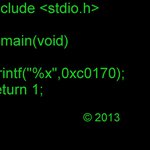The official Mbed 2 C/C++ SDK provides the software platform and libraries to build your applications.
Dependents: hello SerialTestv11 SerialTestv12 Sierpinski ... more
mbed 2
This is the mbed 2 library. If you'd like to learn about Mbed OS please see the mbed-os docs.
TARGET_SAMR21G18A/TOOLCHAIN_GCC_ARM/system.h
- Committer:
- AnnaBridge
- Date:
- 2018-11-08
- Revision:
- 171:3a7713b1edbc
- Parent:
- TARGET_SAMR21G18A/TARGET_Atmel/TARGET_SAM_CortexM0P/drivers/system/system.h@ 111:4336505e4b1c
File content as of revision 171:3a7713b1edbc:
/**
* \file
*
* \brief SAM System related functionality
*
* Copyright (C) 2012-2015 Atmel Corporation. All rights reserved.
*
* \asf_license_start
*
* \page License
*
* Redistribution and use in source and binary forms, with or without
* modification, are permitted provided that the following conditions are met:
*
* 1. Redistributions of source code must retain the above copyright notice,
* this list of conditions and the following disclaimer.
*
* 2. Redistributions in binary form must reproduce the above copyright notice,
* this list of conditions and the following disclaimer in the documentation
* and/or other materials provided with the distribution.
*
* 3. The name of Atmel may not be used to endorse or promote products derived
* from this software without specific prior written permission.
*
* 4. This software may only be redistributed and used in connection with an
* Atmel microcontroller product.
*
* THIS SOFTWARE IS PROVIDED BY ATMEL "AS IS" AND ANY EXPRESS OR IMPLIED
* WARRANTIES, INCLUDING, BUT NOT LIMITED TO, THE IMPLIED WARRANTIES OF
* MERCHANTABILITY, FITNESS FOR A PARTICULAR PURPOSE AND NON-INFRINGEMENT ARE
* EXPRESSLY AND SPECIFICALLY DISCLAIMED. IN NO EVENT SHALL ATMEL BE LIABLE FOR
* ANY DIRECT, INDIRECT, INCIDENTAL, SPECIAL, EXEMPLARY, OR CONSEQUENTIAL
* DAMAGES (INCLUDING, BUT NOT LIMITED TO, PROCUREMENT OF SUBSTITUTE GOODS
* OR SERVICES; LOSS OF USE, DATA, OR PROFITS; OR BUSINESS INTERRUPTION)
* HOWEVER CAUSED AND ON ANY THEORY OF LIABILITY, WHETHER IN CONTRACT,
* STRICT LIABILITY, OR TORT (INCLUDING NEGLIGENCE OR OTHERWISE) ARISING IN
* ANY WAY OUT OF THE USE OF THIS SOFTWARE, EVEN IF ADVISED OF THE
* POSSIBILITY OF SUCH DAMAGE.
*
* \asf_license_stop
*
*/
/*
* Support and FAQ: visit <a href="http://www.atmel.com/design-support/">Atmel Support</a>
*/
#ifndef SYSTEM_H_INCLUDED
#define SYSTEM_H_INCLUDED
#include <compiler.h>
#include <clock.h>
#include <gclk.h>
#include <pinmux.h>
#include <power.h>
#include <reset.h>
#ifdef __cplusplus
extern "C" {
#endif
/**
* \defgroup asfdoc_sam0_system_group SAM System (SYSTEM) Driver
*
* This driver for Atmel® | SMART ARM®-based microcontrollers provides an interface for the configuration
* and management of the device's system relation functionality, necessary for
* the basic device operation. This is not limited to a single peripheral, but
* extends across multiple hardware peripherals.
*
* The following peripherals are used by this module:
* \if DEVICE_SAML21_SYSTEM_SUPPORT
* - PM (Power Manager)
* - RSTC(Reset Controller)
* - SUPC(Supply Controller)
* \endif
* \if DEVICE_SAMC21_SYSTEM_SUPPORT
* - PM (Power Manager)
* - RSTC(Reset Controller)
* - SUPC(Supply Controller)
* \endif
* \if DEVICE_SAMD21_SYSTEM_SUPPORT
* - SYSCTRL (System Control)
* - PM (Power Manager)
* \endif
*
* The following devices can use this module:
* \if DEVICE_SAML21_SYSTEM_SUPPORT
* - Atmel | SMART SAM L21
* \endif
* \if DEVICE_SAMC21_SYSTEM_SUPPORT
* - Atmel | SMART SAM C20/C21
* \endif
* \if DEVICE_SAMD21_SYSTEM_SUPPORT
* - Atmel | SMART SAM D20/D21
* - Atmel | SMART SAM R21
* - Atmel | SMART SAM D10/D11
* - Atmel | SMART SAM DAx
* \endif
*
* The outline of this documentation is as follows:
* - \ref asfdoc_sam0_system_prerequisites
* - \ref asfdoc_sam0_system_module_overview
* - \ref asfdoc_sam0_system_special_considerations
* - \ref asfdoc_sam0_system_extra_info
* - \ref asfdoc_sam0_system_examples
* - \ref asfdoc_sam0_system_api_overview
*
*
* \section asfdoc_sam0_system_prerequisites Prerequisites
*
* There are no prerequisites for this module.
*
*
* \section asfdoc_sam0_system_module_overview Module Overview
*
* The System driver provides a collection of interfaces between the user
* application logic, and the core device functionality (such as clocks, reset
* cause determination, etc.) that is required for all applications. It contains
* a number of sub-modules that control one specific aspect of the device:
*
* - System Core (this module)
* - \ref asfdoc_sam0_system_clock_group "System Clock Control" (sub-module)
* - \ref asfdoc_sam0_system_interrupt_group "System Interrupt Control" (sub-module)
* - \ref asfdoc_sam0_system_pinmux_group "System Pin Multiplexer Control" (sub-module)
*
*
* \if DEVICE_SAML21_SYSTEM_SUPPORT
* \subsection asfdoc_sam0_system_module_overview_vreg_l21 Voltage Regulator
* The SAM device controls the voltage regulators for the core (VDDCORE) and
* backup (VDDBU) domains. It sets the voltage regulators according to the sleep
* modes, the performance level, or the user configuration.
*
* In active mode, the voltage regulator can be chosen on the fly between a LDO
* or a Buck converter. In standby mode, the low power voltage regulator is used
* to supply VDDCORE.
*
* \subsection asfdoc_sam0_system_module_overview_bbps Battery Backup Power Switch
* The SAM device supports connection of a battery backup to the VBAT power pin.
* It includes functionality that enables automatic power switching between main
* power and battery backup power. This will ensure power to the backup domain,
* when the main battery or power source is unavailable.
* \endif
*
* \if DEVICE_SAMC21_SYSTEM_SUPPORT
* \subsection asfdoc_sam0_system_module_overview_vreg_c21 Voltage Regulator
* The SAM device controls the voltage regulators for the core (VDDCORE). It sets
* the voltage regulators according to the sleep modes.
*
* There are a selectable reference voltage and voltage dependent on the temperature
* which can be used by analog modules like the ADC.
* \endif
*
* \subsection asfdoc_sam0_system_module_overview_vref Voltage References
* The various analog modules within the SAM devices (such as AC, ADC, and
* DAC) require a voltage reference to be configured to act as a reference point
* for comparisons and conversions.
*
* The SAM devices contain multiple references, including an internal
* temperature sensor and a fixed band-gap voltage source. When enabled, the
* associated voltage reference can be selected within the desired peripheral
* where applicable.
*
* \subsection asfdoc_sam0_system_module_overview_reset_cause System Reset Cause
* In some applications there may be a need to execute a different program
* flow based on how the device was reset. For example, if the cause of reset
* was the Watchdog timer (WDT), this might indicate an error in the application,
* and a form of error handling or error logging might be needed.
*
* For this reason, an API is provided to retrieve the cause of the last system
* reset, so that appropriate action can be taken.
*
* \if DEVICE_SAML21_SYSTEM_SUPPORT
* There are three groups of reset sources:
* - Power supply reset: Resets caused by an electrical issue. It covers POR and BOD reset.
* - User reset: Resets caused by the application. It covers external reset,
* system reset, and watchdog reset.
* - Backup reset: Resets caused by a backup mode exit condition.
*
* \subsection asfdoc_sam0_system_module_overview_performance_level Performance Level
* Performance level allows the user to adjust the regulator output voltage to reduce
* power consumption. The user can on the fly select the most suitable performance
* level, depending on the application demands.
*
* The SAM device can operate at two different performance levels (PL0 and PL2).
* When operating at PL0, the voltage applied on the full logic area is reduced
* by voltage scaling. This voltage scaling technique allows to reduce the active
* power consumption while decreasing the maximum frequency of the device. When
* operating at PL2, the voltage regulator supplies the highest voltage, allowing
* the device to run at higher clock speeds.
*
* Performance level transition is possible only when the device is in active
* mode. After a reset, the device starts at the lowest performance level
* (lowest power consumption and lowest max. frequency). The application can then
* switch to another performance level at any time without any stop in the code
* execution. As shown in \ref asfdoc_sam0_system_performance_level_transition_figure.
*
* \note When scaling down the performance level, the bus frequency should first be
* scaled down in order to not exceed the maximum frequency allowed for the
* low performance level.
* When scaling up the performance level (e.g. from PL0 to PL2), check the performance
* level status before increasing the bus frequency. It can be increased only
* when the performance level transition is completed.
*
* \anchor asfdoc_sam0_system_performance_level_transition_figure
* \image html performance_level_transition.svg "Performance Level Transition"
*
* \subsection asfdoc_sam0_system_module_overview_power_domain Power Domain Gating
* Power domain gating allows power saving by reducing the voltage in logic
* areas in the device to a low-power supply. The feature is available in
* Standby sleep mode and will reduce the voltage in domains where all peripherals
* are idle. Internal logic will maintain its content, meaning the corresponding
* peripherals will not need to be reconfigured when normal operating voltage
* is returned. Most power domains can be in the following three states:
*
* - Active state: The power domain is powered on.
* - Retention state: The main voltage supply for the power domain is switched off,
* while maintaining a secondary low-power supply for the sequential cells. The
* logic context is restored when waking up.
* - Off state: The power domain is entirely powered off. The logic context is lost.
*
* The SAM L21 device contains three power domains which can be controlled using
* power domain gating, namely PD0, PD1, and PD2. These power domains can be
* configured to the following cases:
* - Default with no sleepwalking peripherals: A power domain is automatically set
* to retention state in standby sleep mode if no activity require it. The application
* can force all power domains to remain in active state during standby sleep mode
* in order to accelerate wakeup time.
* - Default with sleepwalking peripherals: If one or more peripherals are enabled
* to perform sleepwalking tasks in standby sleep mode, the corresponding power
* domain (PDn) remains in active state as well as all inferior power domains (<PDn).
* - Sleepwalking with dynamic power domain gating: During standby sleep mode, a
* power domain (PDn) in active can wake up a superior power domain (>PDn) in order
* to perform a sleepwalking task. The superior power domain is then automatically
* set to active state. At the end of the sleepwalking task, the device can either
* be woken up or the superior power domain can return to retention state.
*
* Power domains can be linked to each other, it allows a power domain (PDn) to be kept
* in active state if the inferior power domain (PDn-1) is in active state too.
*
* \ref asfdoc_sam0_system_power_domain_overview_table illustrates the
* four cases to consider in standby mode.
*
* \anchor asfdoc_sam0_system_power_domain_overview_table
* <table>
* <caption>Sleep Mode versus Power Domain State Overview</caption>
* <tr>
* <th>Sleep mode</th>
* <th>PD0</th>
* <th>PD1</th>
* <th>PD2</th>
* <th>PDTOP</th>
* <th>PDBACKUP</th>
* </tr>
* <tr>
* <td>Idle</td>
* <td>active</td>
* <td>active</td>
* <td>active</td>
* <td>active</td>
* <td>active</td>
* </tr>
* <tr>
* <td>Standby - Case 1</td>
* <td>active</td>
* <td>active</td>
* <td>active</td>
* <td>active</td>
* <td>active</td>
* </tr>
* <tr>
* <td>Standby - Case 2</td>
* <td>active</td>
* <td>active</td>
* <td>retention</td>
* <td>active</td>
* <td>active</td>
* </tr>
* <tr>
* <td>Standby - Case 3</td>
* <td>active</td>
* <td>retention</td>
* <td>retention</td>
* <td>active</td>
* <td>active</td>
* </tr>
* <tr>
* <td>Standby - Case 4</td>
* <td>retention</td>
* <td>retention</td>
* <td>retention</td>
* <td>active</td>
* <td>active</td>
* </tr>
* <tr>
* <td>Backup</td>
* <td>off</td>
* <td>off</td>
* <td>off</td>
* <td>off</td>
* <td>active</td>
* </tr>
* <tr>
* <td>Off</td>
* <td>off</td>
* <td>off</td>
* <td>off</td>
* <td>off</td>
* <td>off</td>
* </tr>
* </table>
*
* \subsection asfdoc_sam0_system_module_overview_ram_state RAMs Low Power Mode
* By default, in standby sleep mode, RAM is in low power mode (back biased)
* if its power domain is in retention state.
* \ref asfdoc_sam0_system_power_ram_state_table lists RAMs low power mode.
*
* \anchor asfdoc_sam0_system_power_ram_state_table
* <table>
* <caption>RAM Back-biasing Mode</caption>
* <tr>
* <th>RAM mode</th>
* <th>Description</th>
* </tr>
* <tr>
* <td>Retention Back-biasing mode</td>
* <td>RAM is back-biased if its power domain is in retention mode</td>
* </tr>
* <tr>
* <td>Standby Back-biasing mode</td>
* <td>RAM is back-biased if the device is in standby mode</td>
* </tr>
* <tr>
* <td>Standby OFF mode</td>
* <td>RAM is OFF if the device is in standby mode</td>
* </tr>
* <tr>
* <td>Always OFF mode</td>
* <td>RAM is OFF if the device is in RET mode</td>
* </tr>
* </table>
*
* \endif
*
* \subsection asfdoc_sam0_system_module_overview_sleep_mode Sleep Modes
* The SAM devices have several sleep modes. The sleep mode controls
* which clock systems on the device will remain enabled or disabled when the
* device enters a low power sleep mode.
* \ref asfdoc_sam0_system_module_sleep_mode_table "The table below" lists the
* clock settings of the different sleep modes.
*
* \anchor asfdoc_sam0_system_module_sleep_mode_table
* <table>
* <caption>SAM Device Sleep Modes</caption>
* \if DEVICE_SAML21_SYSTEM_SUPPORT
* <tr>
* <th>Sleep mode</th>
* <th>System clock</th>
* <th>CPU clock</th>
* <th>AHB/AHB clock</th>
* <th>GCLK clocks</th>
* <th>Oscillators (ONDEMAND = 0)</th>
* <th>Oscillators (ONDEMAND = 1)</th>
* <th>Regulator mode</th>
* <th>RAM mode</th>
* </tr>
* <tr>
* <td>Idle</td>
* <td>Run</td>
* <td>Stop</td>
* <td>Run if requested</td>
* <td>Run</td>
* <td>Run</td>
* <td>Run if requested</td>
* <td>Normal</td>
* <td>Normal</td>
* </tr>
* <tr>
* <td>Standby</td>
* <td>Stop</td>
* <td>Stop</td>
* <td>Run if requested</td>
* <td>Run if requested</td>
* <td>Run if requested or RUNSTDBY = 1</td>
* <td>Run if requested</td>
* <td>Low pwer</td>
* <td>Low pwer</td>
* </tr>
* <tr>
* <td>Backup</td>
* <td>Stop</td>
* <td>Stop</td>
* <td>Stop</td>
* <td>Stop</td>
* <td>Stop</td>
* <td>Stop</td>
* <td>Backup</td>
* <td>Off</td>
* </tr>
* <tr>
* <td>Off</td>
* <td>Off</td>
* <td>Off</td>
* <td>Off</td>
* <td>Off</td>
* <td>Off</td>
* <td>Off</td>
* <td>Off</td>
* <td>Off</td>
* </tr>
* \else
* <tr>
* <th>Sleep mode</th>
* <th>CPU clock</th>
* <th>AHB clock</th>
* <th>APB clocks</th>
* <th>Clock sources</th>
* <th>System clock</th>
* <th>32KHz</th>
* <th>Reg mode</th>
* <th>RAM mode</th>
* </tr>
* <tr>
* <td>Idle 0</td>
* <td>Stop</td>
* <td>Run</td>
* <td>Run</td>
* <td>Run</td>
* <td>Run</td>
* <td>Run</td>
* <td>Normal</td>
* <td>Normal</td>
* </tr>
* <tr>
* <td>Idle 1</td>
* <td>Stop</td>
* <td>Stop</td>
* <td>Run</td>
* <td>Run</td>
* <td>Run</td>
* <td>Run</td>
* <td>Normal</td>
* <td>Normal</td>
* </tr>
* <tr>
* <td>Idle 2</td>
* <td>Stop</td>
* <td>Stop</td>
* <td>Stop</td>
* <td>Run</td>
* <td>Run</td>
* <td>Run</td>
* <td>Normal</td>
* <td>Normal</td>
* </tr>
* <tr>
* <td>Standby</td>
* <td>Stop</td>
* <td>Stop</td>
* <td>Stop</td>
* <td>Stop</td>
* <td>Stop</td>
* <td>Stop</td>
* <td>Low Power</td>
* <td>Source/Drain biasing</td>
* </tr>
* \endif
* </table>
*
* Before entering device sleep, one of the available sleep modes must be set.
* The device will automatically wake up in response to an interrupt being
* generated or upon any other sleep mode exit condition.
*
* Some peripheral clocks will remain enabled during sleep, depending on their
* configuration. If desired, the modules can remain clocked during sleep to allow
* them continue to operate while other parts of the system are powered down
* to save power.
*
*
* \section asfdoc_sam0_system_special_considerations Special Considerations
*
* Most of the functions in this driver have device specific restrictions and
* caveats; refer to your device datasheet.
*
*
* \section asfdoc_sam0_system_extra_info Extra Information
*
* For extra information, see \ref asfdoc_sam0_system_extra. This includes:
* - \ref asfdoc_sam0_system_extra_acronyms
* - \ref asfdoc_sam0_system_extra_dependencies
* - \ref asfdoc_sam0_system_extra_errata
* - \ref asfdoc_sam0_system_extra_history
*
*
* \section asfdoc_sam0_system_examples Examples
*
* For SYSTEM module related examples, refer to the sub-modules listed in
* the \ref asfdoc_sam0_system_module_overview "system module overview".
*
* For a list of examples related to this driver, see
* \ref asfdoc_sam0_drivers_power_exqsg.
*
*
* \section asfdoc_sam0_system_api_overview API Overview
* @{
*/
/**
* \name System Debugger
* @{
*/
/**
* \brief Check if debugger is present.
*
* Check if debugger is connected to the onboard debug system (DAP).
*
* \return A bool identifying if a debugger is present.
*
* \retval true Debugger is connected to the system
* \retval false Debugger is not connected to the system
*
*/
static inline bool system_is_debugger_present(void)
{
return DSU->STATUSB.reg & DSU_STATUSB_DBGPRES;
}
/**
* @}
*/
/**
* \name System Identification
* @{
*/
/**
* \brief Retrieve the device identification signature.
*
* Retrieves the signature of the current device.
*
* \return Device ID signature as a 32-bit integer.
*/
static inline uint32_t system_get_device_id(void)
{
return DSU->DID.reg;
}
/**
* @}
*/
/**
* \name System Initialization
* @{
*/
void system_init(void);
/**
* @}
*/
/**
* @}
*/
/**
* \page asfdoc_sam0_drivers_power_exqsg Examples for Power Driver
*
* This is a list of the available Quick Start Guides (QSGs) and example
* applications. QSGs are simple examples with step-by-step instructions to
* configure and use this driver in a selection of
* use cases. Note that a QSG can be compiled as a standalone application or be
* added to the user application.
*
* \if DEVICE_SAML21_SYSTEM_SUPPORT
* - \subpage asfdoc_sam0_power_basic_use_case
* \endif
*
* \page asfdoc_sam0_system_extra Extra Information for SYSTEM Driver
*
* \section asfdoc_sam0_system_extra_acronyms Acronyms
* Below is a table listing the acronyms used in this module, along with their
* intended meanings.
*
* <table>
* <tr>
* <th>Acronym</th>
* <th>Definition</th>
* </tr>
* <tr>
* <td>PM</td>
* <td>Power Manager</td>
* </tr>
* \if DEVICE_SAML21_SYSTEM_SUPPORT
* <tr>
* <td>SUPC</td>
* <td>Supply Controller</td>
* </tr>
* <tr>
* <td>RSTC</td>
* <td>Reset Controller</td>
* </tr>
* \endif
* \if DEVICE_SAMC21_SYSTEM_SUPPORT
* <tr>
* <td>SUPC</td>
* <td>Supply Controller</td>
* </tr>
* <tr>
* <td>RSTC</td>
* <td>Reset Controller</td>
* </tr>
* \endif
* \if DEVICE_SAMD21_SYSTEM_SUPPORT
* <tr>
* <td>SYSCTRL</td>
* <td>System control interface</td>
* </tr>
* \endif
* </table>
*
*
* \section asfdoc_sam0_system_extra_dependencies Dependencies
* This driver has the following dependencies:
*
* - None
*
*
* \section asfdoc_sam0_system_extra_errata Errata
* There are no errata related to this driver.
*
*
* \section asfdoc_sam0_system_extra_history Module History
* An overview of the module history is presented in the table below, with
* details on the enhancements and fixes made to the module since its first
* release. The current version of this corresponds to the newest version in
* the table.
*
* <table>
* <tr>
* <th>Changelog</th>
* </tr>
* \if DEVICE_SAML21_SYSTEM_SUPPORT
* <tr>
* <td>Initial Release</td>
* </tr>
* \endif
* \if DEVICE_SAMC21_SYSTEM_SUPPORT
* <tr>
* <td>Initial Release</td>
* </tr>
* \endif
* \if DEVICE_SAMD21_SYSTEM_SUPPORT
* <tr>
* <td>Added new \c system_reset() to reset the complete MCU with some exceptions</td>
* </tr>
* <tr>
* <td>Added new \c system_get_device_id() function to retrieved the device
* ID.</td>
* </tr>
* <tr>
* <td>Initial Release</td>
* </tr>
* \endif
* </table>
*
* \page asfdoc_sam0_system_document_revision_history Document Revision History
*
* <table>
* <tr>
* <th>Doc. Rev.</td>
* <th>Date</td>
* <th>Comments</td>
* </tr>
* \if DEVICE_SAML21_SYSTEM_SUPPORT
* <tr>
* <td>42449A</td>
* <td>07/2015</td>
* <td>Initial document release</td>
* </tr>
* \endif
* \if DEVICE_SAMC21_SYSTEM_SUPPORT
* <tr>
* <td>42484A</td>
* <td>08/2015</td>
* <td>Initial document release.</td>
* </tr>
* \endif
* \if DEVICE_SAMD21_SYSTEM_SUPPORT
* <tr>
* <td>42120E</td>
* <td>04/2015</td>
* <td>Added support for SAMDAx</td>
* </tr>
* <tr>
* <td>42120D</td>
* <td>12/2014</td>
* <td>Added support for SAMR21 and SAMD10/D11</td>
* </tr>
* <tr>
* <td>42120C</td>
* <td>01/2014</td>
* <td>Added support for SAMD21</td>
* </tr>
* <tr>
* <td>42120B</td>
* <td>06/2013</td>
* <td>Corrected documentation typos</td>
* </tr>
* <tr>
* <td>42120A</td>
* <td>06/2013</td>
* <td>Initial document release</td>
* </tr>
* \endif
* </table>
*/
#ifdef __cplusplus
}
#endif
#endif /* SYSTEM_H_INCLUDED */
 mbed official
mbed official




